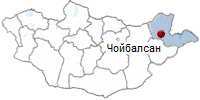Choibalsan. Museum. Memorial. Khiid.
THE REGIONS OF MONGOLIA
DORNOD AIMAG.
CHOIBALSAN


Dornod aimag borders on the North with the Russian Federation and on the East and South-East with the People's Republic of China.
Dornod is ideal for those interested in historical sightseeing. There are the ruins of the Kherlen Bar city of the Kidan period in the 11th century north of
the Kherlen River in Tsagaan Ovoo soum; the wall route of Chinggis Khaan’s crossing of Bayan-Uul, Bayandun, Dashbalbar and Gurvanzagal soums; the Ikh
Burkhant complex created between 1859 and 1864 which is 35km from Khalkh-Gol soum; stone figures from the Tureg period at Shonkh Tavan Tolgoi; the Khiimori
Gobi in Matad soum; stone figures in Khutsuu, Naran and Sergelen soums; the ruins of freedom fighter Count Savaa in Sergelen soum; an artificial mountain
created by Count Togtokhtur of Ilden Khoshuu in Tamsagbulag, Khalkh-Gol soum; the Utai Tavan Mountains; and Turtle Rock or Ger Rock, recorded in “The Secret
History of the Mongols”.
In Khalkh-Gol soum, there is a battlefield dating back to 1939; the Khanan
statue; a statue for Yakovlev; a statue for the Mongolian border troops; the
Statue complex for Victory, the commanding point of G.K. Jukov, the Commander of
the Red Army Corps; the entrenchment of L. Dandar, where he was conferred with
the title of Hero of Mongolia, and the place where M. Ekey was awarded the Hero
of Mongolia.
There are many statues in Choibalsan town, including those for H. Choibalsan,
Soviet pilots, honored author Ts. Damdinsuren; Burte Ujin, poet Z. Nyamsuren,
N.F. Gastello; Soviet hero General Kurilatkin; and a memorial statue at the
place where Byantumen town was bombed; as well as tombs of Soviet troops.
Choibalsan. Population 47,000. Elevation 747m. Named after the Khorloogiyn Choibalsan, this charmless aimag capital is easily Mongolia's largest (after the autonomous cities of
Ulaanbaatar, Darkhan and Erdenet). Centuries ago, the city was a trading center and part of a caravan route across central Asia. It grew into a town in the 19th century, and now the
major economic center for eastern Mongolia. The ethnic groups that reside here are the Khaikh, Buryat, Barga, and Uzemchin.
Choibalsan is a poor city with the highest employment rate in Mongolia. From the ruins of many houses, it looks like Choibalsan has suffered a horrendous earthquake. In fact, the Russian buildings were abandoned after 1990 and the bricks, windows, gates and anything useable have been looted to help build new houses in the town's
East.
The capital is inhabited by a large number of dark-skinned people, a legacy of centuries of intermarriages between Buryats, Bargas, Uzemchins, and Chinese from Inner Mongolia.
PLACES TO VISITED.
-
Museums & Memorials. The City Museum, in the former government house in the old part of town, is probable the best of its kind outside of Ulaanbaator. It contains some interesting
paintings, fascinating old photos, some Choibalsan memorabilia and a giant bowl, made in
1861 which is large enough to boil mutton for 500 people. (The mind boggles, the stomach churns.) The aimag
map marks the location of the many ruined monasteries.
If you desperately miss the requisite stuffed animals in the City Museum, head for the Natural History Museum, on the
West side of the square.
- The G.K.Jukov Museum chronicles the war with the Japanese along the Khalkhin Gol in 1939. It is in the ger suburbs, about 1,5km north-east of the Drama Theatre and 200m
North of the main road.
The caretaker (with the key) lives next door.
- Choibalsan's Mongolian Heroes' Memorial. It is a large arch with a soldier on horseback charging towards the enemy.
- Danrag Danjalan Khiid. According to the chief monk, this monastery was built around 1840 and was once very active. It contained three northern temples and four southern temples, but less than half the 800 monks could be accommodated at one time, so most had to pray outside. The Mongolian security forces descended on the place in 1937, destroyed all records and arrested most of the monks, none of whom has ever been heard from since.
In June 1990 the monastery reopened and it now has two small temples where about 35 monks worship.
ADDITIONAL INFORMATION:
PAGES OF THE PICTURE ALBUM
|